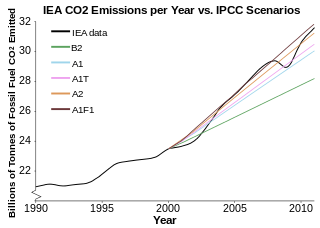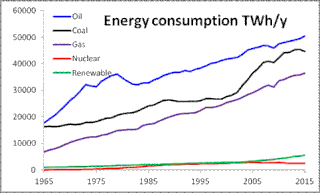Electric power systems consist of generation plants of different energy sources, transmission networks, and distribution lines. Each of these components can have environmental impacts at multiple stages of their development and use including in their construction, during the generation of electricity, and in their decommissioning and disposal. We can split these impacts into operational impacts and construction impacts. This page looks exclusively at the operational environmental impact of electricity generation. The page is organized by energy source and includes impacts such as water usage, emissions, local pollution, and wildlife displacement.

Climate change mitigation consists of actions to limit the magnitude or rate of long-term global warming and its related effects. Climate change mitigation generally involves reductions in human (anthropogenic) emissions of greenhouse gases (GHGs). Mitigation may also be achieved by increasing the capacity of carbon sinks, e.g., through reforestation. Mitigation policies can substantially reduce the risks associated with human-induced global warming.

The share of energy from renewable sources in gross final consumption of energy continued rising to reach 17% in the European Union in 2016, a doubling of the share attained in 2004 at just 8.5%. The Europe 2020 strategy includes a target of reaching 20% of energy in gross final consumption of energy from renewable sources by 2020 and at least 27% by 2030. These figures are based on energy use in all its forms across all three main sectors, the heating and cooling sector, the electricity sector and the transport sector.
The current energy policy of the United Kingdom is set out in the Energy White Paper of May 2007 and Low Carbon Transition Plan of July 2009, building on previous work including the 2003 Energy White Paper and the Energy Review Report in 2006. It was led by the Department of Energy and Climate Change, then headed by Amber Rudd. The current focus of policy are on reforming the electricity market, rolling out smart meters and improving the energy efficiency of the UK building stock through the Green Deal.
The United States was the second-largest energy consumer in 2010 after China. The country is ranked seventh in energy consumption per capita after Canada and several small nations. Not included is the significant amount of energy used overseas in the production of retail and industrial goods consumed in the United States.
A low-carbon economy (LCE), low-fossil-fuel economy (LFFE), or decarbonised economy is an economy based on low carbon power sources that therefore has a minimal output of greenhouse gas (GHG) emissions into the biosphere, but specifically refers to the greenhouse gas carbon dioxide. GHG emissions due to anthropogenic (human) activity are the dominant cause of observed global warming since the mid-20th century. Continued emission of greenhouse gases may cause long-lasting changes around the world, increasing the likelihood of severe, pervasive and irreversible impacts for people and ecosystems.

World energy consumption is the total energy used by the entire human civilization. Typically measured per year, it involves all energy harnessed from every energy source applied towards humanity's endeavours across every single industrial and technological sector, across every country. It does not include energy from food, and the extent to which direct biomass burning has been accounted for is poorly documented. Being the power source metric of civilization, World Energy Consumption has deep implications for humanity's socio-economic-political sphere.

According to the U.S. Energy Information Industry (EIA), the United States produced 5.14 billion metric tonnes of carbon-dioxide equivalent greenhouse gas (GHG) emissions in 2017, the lowest since the early 1990s. From year to year, emissions rise and fall due to changes in the economy, the price of fuel and other factors. The US Environmental Protection Agency attributed recent decreases to a reduction in emissions from fossil fuel combustion, which was a result of multiple factors including switching from coal to natural gas consumption in the electric power sector; warmer winter conditions that reduced demand for heating fuel in the residential and commercial sectors; and a slight decrease in electricity demand.

Ensuring adequate energy supply to sustain economic growth has been a core concern of the Chinese government since 1949. Primary energy use in China was 26,250 TWh and 20 TWh per million persons in 2009. According to the International Energy Agency, the primary energy use grew 40% and electricity use 70% from 2004 to 2009.

Fossil fuel phase out refers to the discontinuation of the use of fossil fuels, through the decommissioning of operating fossil fuel-fired power plants, the prevention of the construction of new ones, and the use of alternative energy to replace the role of fossil fuels.

The endeavor to use 100% renewable energy for electricity, heating/cooling and transport is motivated by global warming, pollution and other environmental issues, as well as economic and energy security concerns. Shifting the total global primary energy supply to renewable sources requires a transition of the energy system. According to the Intergovernmental Panel on Climate Change there are few fundamental technological limits to integrating a portfolio of renewable energy technologies to meet most of total global energy demand. Renewable energy use has grown more quickly than even advocates anticipated. As of 2019, however, it needs to grow six times faster to limit global warming to 2 °C (3.6 °F).

Energy in Finland describes energy and electricity production, consumption and import in Finland. Energy policy of Finland describes the politics of Finland related to energy. Electricity sector in Finland is the main article of electricity in Finland.
The energy policy of Malaysia is determined by the Malaysian Government, which address issues of energy production, distribution, and consumption. The Department of Electricity and Gas Supply acts as the regulator while other players in the energy sector include energy supply and service companies, research and development institutions and consumers. Government-linked companies Petronas and Tenaga Nasional Berhad are major players in Malaysia's energy sector.
The green paradox is the title of a controversial book by German economist, Hans-Werner Sinn, describing the observation that an environmental policy that becomes greener with the passage of time acts like an announced expropriation for the owners of fossil fuel resources, inducing them to accelerate resource extraction and hence to accelerate global warming.
Italy consumed about 185 Mtoe of primary energy in 2010. This came mostly from fossil fuels. Among the most used resources are petroleum, natural gas, coal and renewables.
Energy in the Middle East describes energy and electricity production, consumption and import in the Middle East. Energy policy of the Middle East will describe the politics of the Middle East related to energy more in detail.

The carbon bubble is a hypothesized bubble in the valuation of companies dependent on fossil-fuel-based energy production, because the true costs of carbon dioxide in intensifying global warming are not yet taken into account in a company's stock market valuation. Currently the price of fossil fuels companies' shares is calculated under the assumption that all fossil fuel reserves will be consumed. An estimate made by Kepler Chevreux puts the loss in value of the fossil fuel companies due to the impact of the growing renewables industry at US$28 trillion over the next two decades-long. A more recent analysis made by Citi puts that figure at $100 trillion.
Worldwide energy supply is the global production and preparation of fuel, generation of electricity, and energy transport. Energy supply is a vast industry, powering the world economy. More than 10% of the world expenditures is used for energy purposes.

Acharavadee Wongsakon is a Thai lay Buddhist teacher and former entrepreneur who teaches a form of Vipassana meditation called Techo Vipassana Meditation. She teaches this method to laypersons and ordained buddhist monks at various Techo Vipassana centers throughout Thailand. She is the founder of the Knowing Buddha Organization, which campaigns against disrespectful uses of Buddha imagery and the general decline of morality in society. Acharvadee and the Knowing Buddha Foundation have been endorsed by the National Office of Buddhism.











